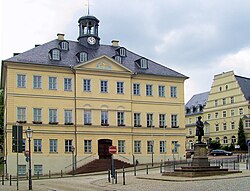
Dresden is the capital city of the German state of Saxony and its second most populous city after Leipzig. It is the 12th most populous city of Germany, the fourth largest by area, and the third most populous city in the area of former East Germany, after Berlin and Leipzig. Dresden's urban area comprises the towns of Freital, Pirna, Radebeul, Meissen, Coswig, Radeberg and Heidenau and has around 790,000 inhabitants. The Dresden metropolitan area has approximately 1.34 million inhabitants.

Zwickau is, with around 87,500 inhabitants (2020), the fourth-largest city of Saxony, Germany, after Leipzig, Dresden and Chemnitz and it is the seat of the Zwickau District. The West Saxon city is situated in the valley of the Zwickau Mulde, and lies in a string of cities sitting in the densely populated foreland of the Elster and Ore Mountains stretching from Plauen in the southwest via Zwickau, Chemnitz and Freiberg to Dresden in the northeast. From 1834 until 1952, Zwickau was the seat of the government of the south-western region of Saxony.

Chemnitz is the third-largest city in the German state of Saxony after Leipzig and Dresden. Chemnitz is the third-largest city in the Thuringian-Upper Saxon dialect area after Leipzig and Dresden. It is the fifth largest city in the area of former East Germany after (East) Berlin, Leipzig, Dresden and Halle. The city is part of the Central German Metropolitan Region, and lies in the middle of a string of cities sitting in the densely populated northern foreland of the Elster and Ore Mountains, stretching from Plauen in the southwest via Zwickau, Chemnitz and Freiberg to Dresden in the northeast.

Freiberg is a university and former mining town in Saxony, Germany. It is a Große Kreisstadt and the administrative centre of Mittelsachsen district.
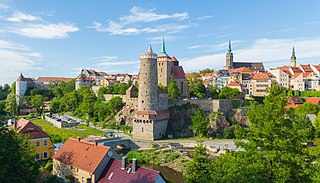
Bautzen or Budyšin, until 1868 Budissin in German, is a town in eastern Saxony, Germany, and the administrative centre of the district of Bautzen. It is located on the Spree river, is the eighth most populous town in Saxony, and is the seat of Saxony's largest district. Bautzen lies in the bilingual Sorbian settlement area of Lusatia, and is Lusatia's third-largest town after Cottbus and Görlitz, as well as the second-largest town in Upper Lusatia.

Barkas was the East German manufacturer of small delivery vans and minibuses named the B 1000. In addition to delivery vans, Barkas also made engines for Trabant cars.
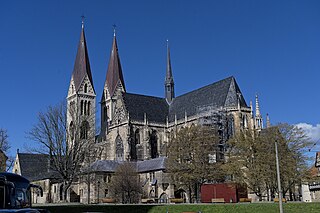
Halberstadt is a town in the German state of Saxony-Anhalt, the capital of Harz district. Located north of the Harz mountain range, it is known for its old town center, which was largely destroyed by Allied bombings in the late stages of World War II after local Nazi leaders refused to surrender. The town was rebuilt in the following decades.

Plauen is, with around 65,000 inhabitants, the fifth-largest city of Saxony, Germany after Leipzig, Dresden, Chemnitz and Zwickau, the second-largest city of the Vogtland after Gera, as well as the largest city in the Saxon Vogtland. The city lies on the river White Elster, in the Central Vogtlandian Hill Country. Plauen is the southwesternmost city of a string of cities sitting in the densely populated foreland of the Elster and Ore Mountains, stretching from Plauen in the southwest via Zwickau, Chemnitz and Freiberg to Dresden in the northeast. It is the capital of the Vogtland District. Plauen borders Thuringia to the north, and it is also situated near the Saxon border with Bavaria (Franconia) and the Czech Republic (Bohemia).

Bad Gottleuba-Berggießhübel is a spa town in the district Sächsische Schweiz-Osterzgebirge in Saxony, in eastern Germany. The municipality borders the Czech Republic in the south. The municipality was formed on 1 January 1999 by the merger of the former municipalities Bad Gottleuba, Berggießhübel, Langenhennersdorf, and Bahratal. Surrounded by forests and near a water dam, Bad Gottleuba-Berggießhübel has several facilities including a spa health park, a plant garden, and a heated open air pool.

Mittweida is a town in Saxony, Germany, in the Mittelsachsen district.

Eilenburg is a town in Germany. It lies in the district of Nordsachsen in Saxony, approximately 20 km northeast of the city of Leipzig.
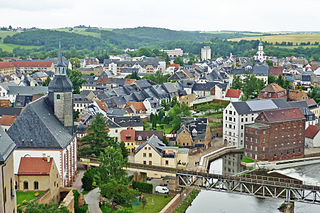
Rochlitz is a major district town in the district of Mittelsachsen, in Saxony, Germany. Rochlitz is the head of the "municipal partnership Rochlitz" with its other members being the municipalities of Königsfeld, Seelitz and Zettlitz.

Oederan is a town in the district of Mittelsachsen, in Saxony, Germany.
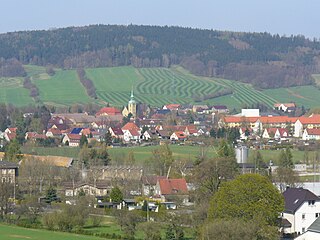
Wilthen (German) or Wjelećin is a town in the district of Bautzen, in Saxony, Germany. It is near the border with the Czech Republic, 9 kilometres (5.6 mi) south of Bautzen and 50 kilometres (31 mi) east of Dresden.
Hainichen concentration camp is a concentration camp at Öderanstrasse in Hainichen, Saxony, formed on April 4, 1933, by order of Amtshauptmann Döbeln. Ortsgruppenleiter Georg "Zuff" Ziegler was the commandant and Friedrich Zill served as his deputy. The guards consisted of SA-Sturm 5/139, later supplemented by SA-Sturmbann II/148 from Colditz. Despite the nomenclature, Hainichen was an early concentration camp for leftist detainees. Its population fluctuated from an initial 50 prisoners to 144 by April 12, then to nearly three hundred before its dissolution on June 13, 1933.
Mittelsachsen is a district (Kreis) in the Free State of Saxony, Germany.

Osterstein Castle is the former castle of the town of Zwickau, Germany, in Saxony. Now it houses a nursing home.
Framo was a minivan, motor tricycle and car manufacturer in Saxony, Germany. It was established by Danish engineer Jørgen Skafte Rasmussen, the founder of DKW, in 1923. Framo became the core of the Barkas minivan manufacturer in 1957.
In the first half of the 20th century, the firm of Polte Armaturen- und Maschinenfabrik OHG in Magdeburg, Germany was an important manufacturer of large fittings and one of the largest ammunition producers in the world. The group was one of the most important employers in Magdeburg, a pioneer in the construction of sanitary and social facilities for employees and workers and internationally appreciated for the engineering quality of its products. After the Second World War, it was mainly known for the mass employment of forced laborers and concentration camp prisoners. The parts of the Polte-Werke that were not destroyed during the war or transported away by the Soviet occupying forces as reparations were later merged into the VEB Schwerarmaturenwerk "Erich Weinert" and the resulting VEB Magdeburger Armaturenwerke "Karl Marx".
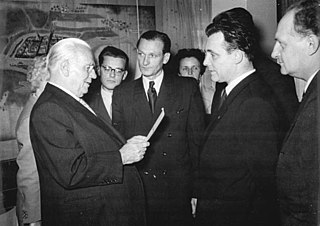
Curt Wach was a German politician (KPD/SED). He served as Chairman of the Potsdam District Council and as Minister of Trade and Supply in the GDR.
